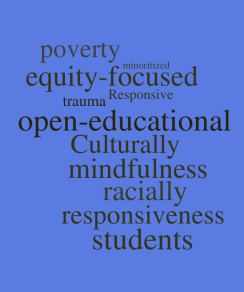In this blog post, I am sharing a synergy I’ve been struck by while working on a year-long sabbatical project to create an intensive faculty cohort training focused on culturally responsive pedagogy (CRP) at Minneapolis Community & Technical College. The defining goal of the training is to decrease our college’s equity gaps between white students and racially minoritized students.
I have been inspired by the ways in which culturally responsive pedagogy overlaps with poverty-responsive pedagogy, mindfulness and equity pedagogy, trauma-responsive pedagogy, and open-educational pedagogy.
The foundational inspiration for the Minneapolis Model Training at Minneapolis College is Zaretta Hammond’s 2015 book Culturally Responsive Teaching & the Brain. In this text, Dr. Hammond offers a combination of theoretical grounding and practical suggestions for instructors to create learning communities that invite all students to flourish by focusing attention on shifting from teaching practices that were mainly culturally responsive to white culture to include practices that are culturally responsive to racially minoritized students as well.
What follows are some of the central elements of Dr. Hammond’s articulation of culturally responsive teaching, and how the additional teaching perspectives can support them.
Developing practices and spaces that allow community members to maintain a calm, alert focus
By practicing equity-focused mindfulness, faculty members can better maintain a calm, alert focus and better understand their internalized biases and oppressions. This understanding is key to our ability to pause, reflect, and act from our best selves. Shifting away from unconsciously reacting out of our internalized misconceptions is key to creating spaces that allow students to maintain a calm, alert focus. This is especially critical on my campus, where 70% of students are underrepresented (students of color, first-generation, and/or low-income students). As instructors, we need to build in reflective practices in the continual work of unlearning the stereotypes we are bombarded with among the communities we work with and within.
Developing practices and spaces in which we can be as unimpeded as possible by fear and exclusion to push ourselves beyond current limits
Given our student population, most of our learners will be carrying the burdens of the traumas of racism. By having some background in the brain’s responses to trauma, we can more compassionately support students as they heal from trauma; this knowledge can also guide us away from retraumatizing students with classroom policies that ignore trauma.
Having high expectations for all students and scaffolds to support students’ efforts to reach those standards
One of the main tenets of CRP is that high expectations have been unequally distributed across the education system, with racially minoritized students offered fewer opportunities for higher-level learning. By using the principle from open-educational pedagogy that students’ work should center on their creative contributions to the knowledge of our discipline, we can ensure we have set higher-level learning goals for students and have the bandwidth to create the scaffolds students need: every student has strengths he or she brings into the classroom that can be leveraged in the creation of learning scaffolds. Students help other students by creating the learning materials and, in so doing, learn the material more deeply!
Developing practices and spaces that foster deep connection and community, especially via instructors who are warm demanders; embedding practices and ways of knowing from oral culture
Dr. Hammond emphasizes the importance of relationships and oral cultural practices in the lives of racially minoritized students and advocates that instructors infuse both in classrooms. This is echoed in the work of Dr. Donna Beegle in See Poverty…Be the Difference. By knowing the benefits and practices of oral culture and the importance of mentoring as developed by Dr. Hammond and Dr. Beegle, we can more fully embed these practices as we build connections with students.
While reading the above tenets of CRP, I hope the correlation among the different pedagogical perspectives is clear. Equity mindfulness, trauma-responsiveness, poverty-responsiveness, open-educational responsiveness, and culturally responsive teaching are all connected. Together, they offer an inspiring, interconnected nesting of support as we continue to develop our craft of teaching. Also, through each of these perspectives runs a core grounding of love—love for the brilliance and possibility our students offer within the work of our respective disciplines.
In the comments section, please add your own experiences with how these pedagogies (and others) connect and enhance one another in our work to decrease equity gaps.
For more information on equity-focused mindfulness, see Dr. Beth Berila’s Integrating Mindfulness into Anti-Oppression Pedagogy and associated website: Contemplative Practices for Anti-Oppression Pedagogy
For more information on trauma-responsive practices, see SAMHSA’s Concept of Trauma and Guidance for a Trauma-Informed Approach
For more information on open-educational pedagogy, see David Wiley’s “Iterating toward Openness” and “Open Pedagogy” by Robin DeRosa and Rajiv Jhangiani
Lisa Bergin is an Engaging Excellence in Equity Fellow who participated in convenings designed to identify culturally responsive practices and further support-building evidence and capacity for this work. Learn more about the project.
